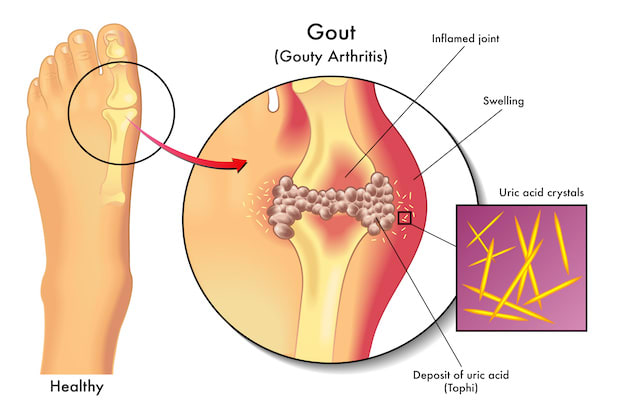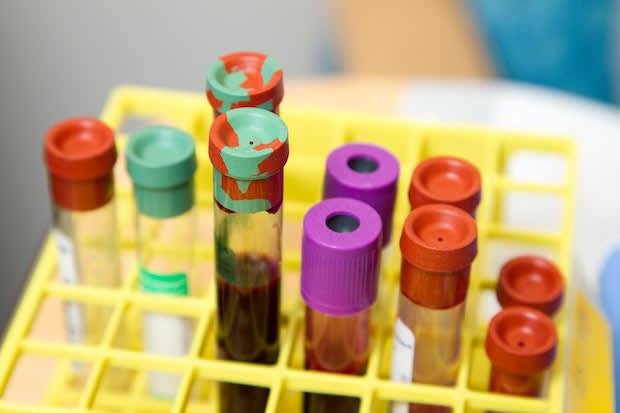Table of Contents
II. Is Gout a Type of Arthritis?
What is Gout?
Gout is a condition that occurs in four percent of the United States population. This percentage equates to eight million people in the country and is becoming more and more common. It is thought that the rise in gout is related to the nation’s increasing obesity crisis and high blood pressure issues. [1]
This condition occurs when uric acid crystals build up in the joints. Uric acid is a natural waste product that circulates throughout the bloodstream. Uric acid levels increase when the body digests foods that contain purines. These foods often include sardines, dried beans, beer, and red meat. Typically, the body filters out uric acid through the kidneys, but they may build up if too many purines are consumed. The extra uric acid in the blood can lead to the formation of uric crystals in the joints. It may also make your blood and urine too acidic. [2]
Gout can be very uncomfortable, and you may require medications to regulate the symptoms. Your doctor may prescribe colchicine, Zyloprim (allopurinol), or indomethacin (or indomethacin suppositories). Read on to learn more about gout and the risk factors that cause this joint condition.
Yes, gout is classified as a variant of arthritis. Because gout can lead to joint stiffening and inflammation, it falls under the umbrella of debilitating arthritic conditions. The big toe is most commonly affected, but gout pain and uric crystal formation may also occur in the knee, ankle, foot, hand, wrist, or elbow. Gout attacks are often sudden and cause pain that lasts three to ten days. In general, the first 36 hours of a gout attack are the most painful. Many arthritis types are genetic or develop over time, but lifestyle choices more commonly cause gout. Over time, gout may cause deformities caused by a severe uric crystal buildup. This is known as tophi and can lead to permanent lumps under the skin around a joint. [3] Gout occurs slowly over time, and symptoms may not be noticeable at first. All of a sudden, one night, you may experience the tell-tale signs of gout and experience painful symptoms. The most common symptoms of this disorder include: A combination of several factors can increase a person’s risk of gout. It is much more common in obese males, mainly due to the accompanying health disorders that come with carrying excess weight. Health conditions that may increase your risk of gout include: As mentioned earlier, eating high-purine foods can increase the presence of uric acid in the body. These foods include organ meat, red meat, anchovies, sardines, mussels, scallops, trout, and tuna. Consuming alcohol regularly, drinking high-sugar beverages, and eating high fructose foods may also lead to gout. [5] Depending on the severity of your gout, your doctor may order several tests. If you are unsure if you are experiencing gout, you may want to keep a journal of your symptoms to help your doctor determine the right tests for you. These tests may include: Joint fluid test: A doctor may use a needle to draw fluid from the joint that is causing you pain. This sample will be examined for urate crystals under a microscope. Blood test: A blood sample will measure the levels of uric acid in the blood. In some cases, uric acid may be present in the blood, but the patient may not be experiencing gout symptoms. Ultrasound and X-rays: A doctor can do an ultrasound on the affected joint or tophi. This tool can detect the presence of urate crystal formation. An x-ray can detect the presence of joint inflammation. [4] Treating gout is often a multifaceted process. In many cases, you will likely have to alter some of your lifestyle habits to prevent gout from becoming more severe. Along with these changes, you will likely be prescribed medications like colchicine, Zyloprim (allopurinol), or indomethacin. These medications remove uric acid from the blood to prevent kidney stones, chronic kidney disease, and tophi formation. Medications may also improve the kidney’s ability to remove uric acid from the body. After a few weeks or months of new medications, your doctor may give you another joint fluid or blood test to check for the presence of uric crystals. If you need help making a gout-friendly diet, you may want to consult a dietician to help with meal planning. Gout may be painful, but with the proper diet and medications, your symptoms will improve. [4] The content in this article is intended for informational purposes only. This website does not provide medical advice. In all circumstances, you should always seek the advice of your physician and/or other qualified health professionals(s) for drug, medical condition, or treatment advice. The content provided on this website is not a substitute for professional medical advice, diagnosis, or treatment.
Is Gout a Type of Arthritis?
Symptoms of Gout

Gout Risk Factors
Diagnosing Gout

General Treatment Options
